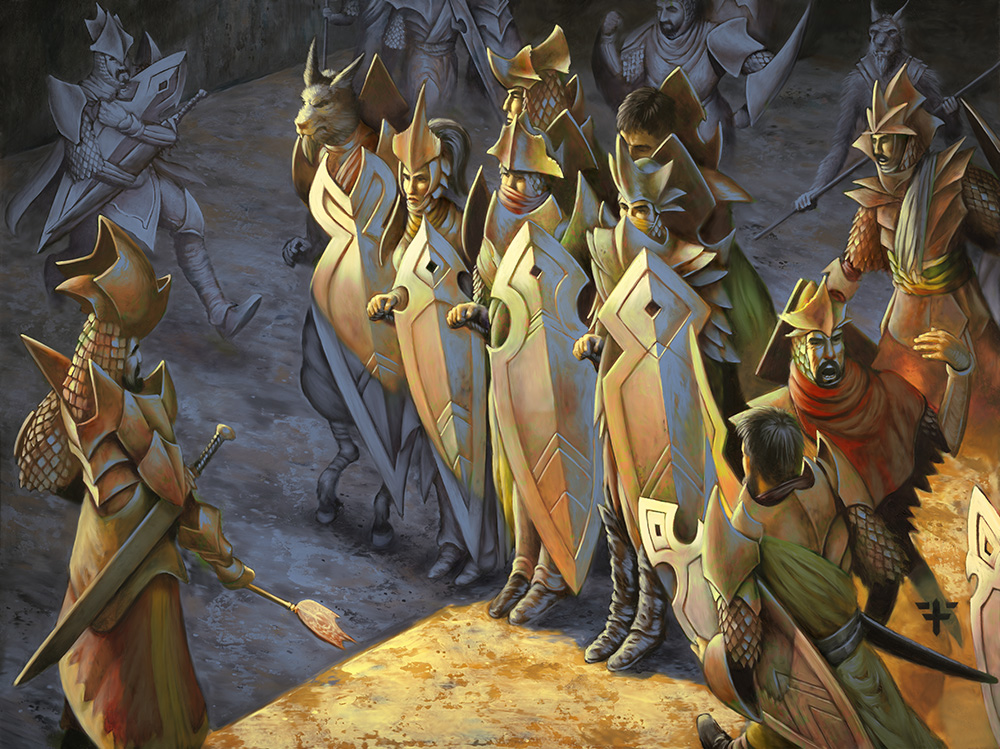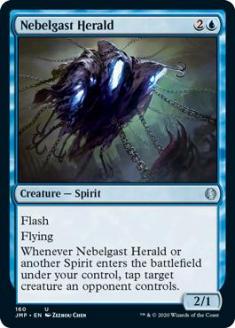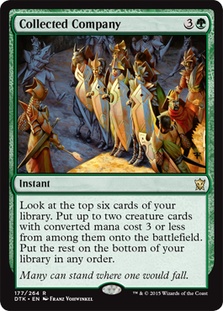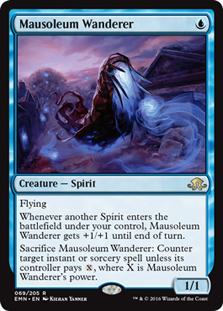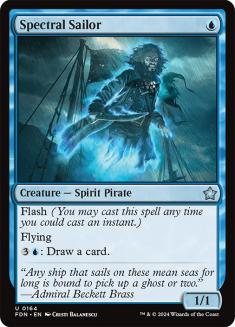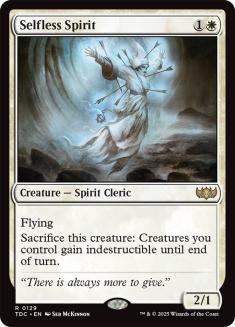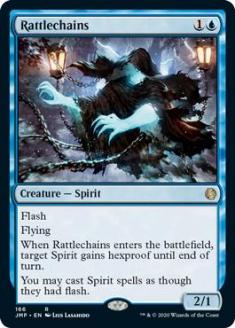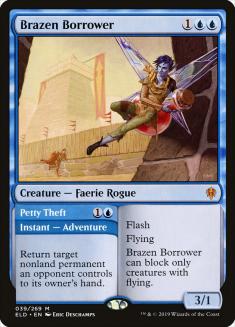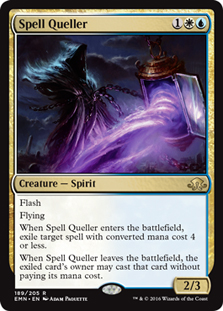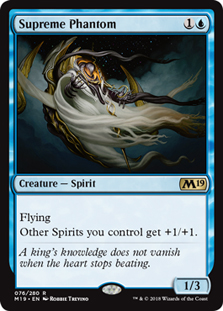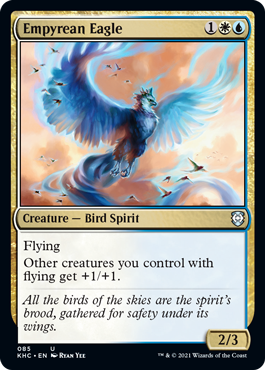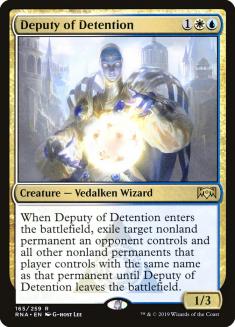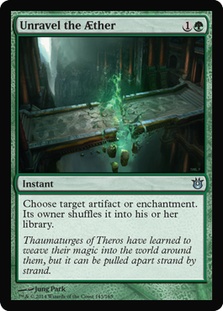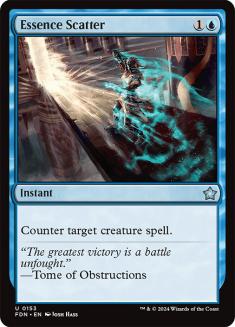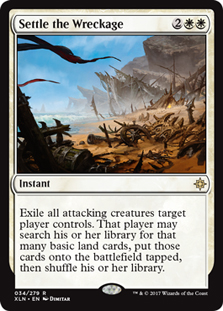Bant Spirits is the best deck in Pioneer. Before it added Collected Company, I thought Max McVety’s Azorius Spirits was going to end up being the best deck in Pioneer, but this past weekend’s Players Tour results showed me that adding Collected Company just makes the deck more powerful, significantly increasing its win percentage against the field.
Did you ever have to play against Faeries back when it was in Morningtide Standard? Every single card your opponent casts is at flash speed. Their threats are able to obnoxiously tap down or stall your creatures, counter your spells, all while turning the corner thanks to eight extremely efficient lords. It can be maddening to play against, simply because the opponent can cast whatever threat is most efficient or annoying for you at any given time. Since everything has flash, they can cast it after you’ve cast your threat to continue throwing you off-balance.
When your opponent’s threat suite is all castable at instant speed, it becomes much harder to formulate a plan. A single creature cast off a single mana at instant speed can dramatically change the clock. Not only is every flash creature good on its own, able to start chipping away, but the two lord effects turn any small creature into a very real threat. And with Collected Company on the top-end, you can find multiple lords in a single turn, giving added value to literally any Spirit or flying creature.
Before we move into the heart of the article, I wanted to share my current list with y’all. Join me as we examine it and break down exactly what we’re playing and why!
Creatures (32)
- 4 Rattlechains
- 4 Spell Queller
- 4 Selfless Spirit
- 4 Mausoleum Wanderer
- 4 Nebelgast Herald
- 4 Supreme Phantom
- 4 Empyrean Eagle
- 4 Spectral Sailor
Lands (20)
Spells (8)

It’s no secret that allied-color decks have tough mana in this format. Adding a color doesn’t actually hurt all that much, as you’ll likely be taking just as much damage from your lands or having just as many lands enter the battlefield tapped. So when someone started playing Collected Company in the already successful Azorius Spirits deck, it seemed like a no-brainer…because it is a no-brainer. The first versions of Spirits in the format had Collected Company, but what’s changed? Why is Collected Company better now than it was before?
It’s hard to quantify exactly what makes this deck tick, but I think Nebelgast Herald is likely the card that put Collected Company over the top. Triggering upon entering the battlefield instead of on casting means Collected Comapny either finding Nebelgast Herald or already having one on the battlefield means your opponent isn’t attacking with many creatures anytime soon.
Since Pioneer contains a lot of combat, cards like Nebelgast Herald are significantly better here than in something like Modern or even Legacy. For those who played with it in Draft or Sealed, you know how potent it can be when the combat step is a huge part of the game. And while combo decks are starting to pop up here and there, many opponents you face will be attacking you with creatures. And because of that, and as long as that is the case, Nebelgast Herald will be an all-star in this archetype.
Sideboard: Cut this one against opponents with few or no creatures.
I heard that adding Collected Company to the Azorius Spirits deck added 10% to the win percentage of archetype at PT Nagoya. With two copies in the Top 8, it feels like playing Collected Company in this deck is just a slam dunk. And it should be, but some part of me thinks it might actually just be training wheels. It’s been in the back of my head every since I saw this tweet.
Max is an incredibly talented player with a penchant for playing aggressive strategies. If he’s questioning playing Collected Company, then maybe I should to. But what do you get when you cut Collected Company? Adding Mutavault to the deck makes a bunch of sense. After all, it is a Spirit to be pumped with Supreme Phantom. But since allied-color mana is so bad, playing Mutavault is actually pretty tough on the mana because you have to play fewer Plains or Island for Port Town.
I also think playing just Azorius colors means you get to lower your curve a little bit. For example, I think Essence Scatter is exceptionally good right now, which is why I’m playing two copies in the sideboard of the Bant version. I’m under the impression that it will be very good in the maindeck if it is put there, but can’t really fit alongside Collected Company, as playing that spell means you need to keep your threat density super-high.
Sideboard: Cut one or more when you’re lowering your overall creature count significantly.
Mausoleum Wanderer gets my vote for best card in the deck, if only because it’s the only card I want to draw every single game on the first turn, and is cheap enough and disruptive enough to have an impact even if drawn “too late” for conventional one-mana creatures.
Mausoleum Wanderer hits so hard so quickly, and is usually just big enough to counter or threaten to counter your opponent’s on-curve piece of interaction. Honestly, any draw featuring a first-turn Mausoleum Wanderer is almost always going to be better than a draw without. My theory was that capping out on Spectral Sailor is also important for similar reasons, because it ultimately ends up being any amount of pressure, which is better than no pressure. Starting the beats early and having as many cheap bodies to gain the buff from the lord creatures as possible is exactly how I want to build and streamline the archetype.
Sideboard: Never cut this card.
One of the more highly contested slots in the deck, Spectral Sailor has my pick as a four-of because it’s one of the few early plays you can make to put Supreme Phantom to good use. With two creatures that pump your whole squad, any body is relevant. Spectral Sailor costing one mana is also a huge deal, as it can let you do some cool stuff with Nebelgast Herald when you’re light on lands.
And if you’re heavy on lands, being able to draw cards is also huge. If you have four mana up, it’s impossible for your opponents to play around Collected Company. And if they don’t attack, you can always just draw a card with that four mana.
It’s minor, but the threat of drawing a card is real, and especially great when you’re flooding or just having all your creatures killed on the spot. The trick is having too many creatures that are good and need killing so that your opponent will eventually run out of removal. And when that happens, the Spectral Sailor stands alone.
Sideboard: Trim one or two if necessary against opponents with stuff like Goblin Chainwhirler.
One of your better cards against Supreme Verdict or other sweeper effects, Selfless Spirit is solid but not exactly an MVP. When you get to protect Spell Queller, it’s outrageous. When you need a good blocker or some real pressure? You can certainly do better. It doesn’t have flash, and it doesn’t do anything all that flashy in your deck, but it plays a certain role very well.
Sideboard: Weak against Goblin Chainwhirler, but excellent against just about everything else.
I used to think that Rattlechains was a card you played to protect your other Spirits with the hexproof mechanic. But after playing with the archetype, I found myself wanting to give all my other creatures flash more than wanting to give anything hexproof. The value of being able to play everything at instant speed, including your lord effects, means your Spell Queller is much better, and you get to completely dictate the pace of the game.
Rattlechains protecting stuff with the hexproof ability is just icing on the cake. It doesn’t happen often, but when it does it’s a complete blowout. I’m a huge fan of this card in the archetype. I’ve seen some people cut one, and I highly recommend against it. I’d much rather trim a Selfless Spirit if you have to, but keeping the curve low is better if you ask me. We don’t need no stinkin’ Brazen Borrower!
Sideboard: Never cut this card. It adds an entirely new dimension to your deck that opponents just can’t handle sometimes.
Speaking of Brazen Borrower, zero, I’ve left them all on the sidelines. It’s hard to explain why exactly, but the new population of combo decks leaves you with fewer fair decks, and that means the bounce ability is not nearly as potent. While Petty Theft is certainly fine to cast most of the time, the card Brazen Borrower is only as good as Petty Theft. A 3/1 flyer is certainly solid, but not worth it on its own.
If a few of the combo decks get the axe, or fall off in popularity, Brazen Borrower will see more play and get much better. Until then, I’d rather just focus on the Spirits theme and make Nebelgast Herald as powerful as possible.
This isn’t centered just around Brazen Borrower, though. Even Bonecrusher Giant is mediocre at the moment. Too few creatures and those that do see play have high toughness to boot, ultimately making Stomp a lot worse, which makes the card Bonecrusher Giant mediocre as a result. When the unfair decks start to see more play, cards that are excellent in fair metagames get significantly worse. Just think about it: when was the last time Glorybringer felt great?
An obvious MVP, Spell Queller is one of the best spells in your arsenal against unfair decks, but is even pretty darn good against fair decks if you have one or two ways to protect it. Spell Queller is also an outrageous hit off Collected Company if your opponent is casting an important spell!
I probably don’t need to sing the praises of Spell Queller. It’s obviously weak if the opponent has a ton of removal, but when you combine it with Selfless Spirit, something magical happens. Don’t be afraid to just cast this if you need some pressure. There’s nothing worse than dying with one or two copies of Spell Queller rotting in your hand.
The best part of Spell Queller, like the best cards in Pioneer, is that it’s diverse in its utility. When you get to counter an opposing spell and untap with a live Spell Queller, it’s very hard to lose. But just be careful, and be hyper-aware of when you should be casting Spell Queller for average beatdown purposes.
Sideboard: I never sideboard these out if I can help it.
These two give a lot of life to your ragtag group of creatures. Turning all of your small flyers into real threats is huge, as anyone who has played any Aether Vial deck should know. The lord effects in Magic are timeless, powerful, and ultimately some of the most fun and fair Magic you can play. That type of interaction between you and all your creatures helps generate a massive amount of pressure that punishes people for not playing a ton of removal. It’s one of the reasons why I think the deck is well-positioned right now.
These two lords, while important for racing, don’t actually interact with the opponent that well, but they are lightning rods for removal so that your other creatures might live! And if Spell Queller lives, well, we’ve already covered that.
These two threats are important for the archetype as a whole, but I can’t even tell you how often I sideboard out Empyrean Eagle against opponents who have Supreme Verdict or other sweepers. I never sideboard out Supreme Phantom, but that’s mostly because of how efficient it is. Three mana is where you start holding up mana every turn, so tapping out for Empyrean Eagle is a bit dangerous. Regardless, these two are some of your better threats against combo decks because they help reduce the clock tremendously.
Sideboard: Never sideboard out Supreme Phantom. It’s too efficient. Empyrean Eagle can get trimmed or cut entirely on the regular.
Using Your Sideboard
This one should be no surprise. Nearly every Spirits deck I’ve seen in the last year has Deputy of Detention somewhere. It’s especially good with Collected Company, giving you a pretty big tempo boost and answer to annoying permanents while having the slight vulnerability to removal. This again falls under the “too many good creatures to kill everything” plan, in hopes that something eventually sticks because your opponent couldn’t quite kill everything. It also completely owns when paired with Selfless Spirit.
I’ve long considered replacing this with Reflector Mage, as you can bring it in against virtually any deck featuring creatures and it would be extremely good, but randomly tagging enchantments or planeswalkers is useful.
Sideboard: Bring in if your opponent has a ton of permanents and not a lot of removal, or if you’re desperate for some type of interaction.
Unravel the Aether is one of the few ways you can interact with an opponent who has an indestructible Heliod, Sun-Crowned, but is also randomly good against opponents who are casting Ensoul Artifact on Darksteel Citadel. Hangarback Walker giving you trouble? Put it back in the deck!
Mostly this is just a concession to people having enchantments or artifacts that are indestructible. Since we’re splashing green for Collected Company, having a few more green cards just makes sense. I might be off-base here but Unravel the Aether just feels like the best choice for that spot.
Sideboard: Bring in against annoying artifacts or enchantment decks.
If Azorius Spirits ends up being better than splashing for Collected Company, it will almost certainly be because it can play Essence Scatter in the maindeck. It stops Inverter of Truth and Thassa’s Oracle while still having utility against a wide range of opponents. I think having a few copies in the sideboard for the right decks while on the play will be great.
Mostly I just want to lower my curve while giving myself more interaction. I can’t justify playing Essence Scatter in the maindeck, as you need a high density of threats to make Collected Company work. However, the Azorius builds can handle a few more noncreature spells. White and blue don’t have a ton of ways interact with creatures in an efficient way, so Essence Scatter is a hot one for that slot.
Sideboard: Great against midrange or opponents with medium or large creatures that are susceptible to it. Bad against decks featuring a ton of one-mana threats.
I might end up playing four copies of Mystical Dispute, but I’ve been very happy just playing three in most of my blue sideboards. It’s just one of the best sideboard cards we’ve seen in ages and allows for some blue decks to have a fighting chance against other blue decks, and I think that’s wonderful.
Sideboard: Is your opponent playing blue spells? Bring it in!
One of, powerful sideboard option when it works. Embarrassing when it doesn’t. Settle the Wreckage is not a card I recommend for the faint of heart, but the feeling of just dumpstering your opponent when they try to race is huge. I’ve tried two, but drawing more than one is useless and sometimes drawing the first is pretty bad.
Sideboard: Use sparingly, and only against opponents where racing is very difficult.
One of the more potent answers to some of the format’s more problematic decks, Rest in Peace is something I recommend in high numbers this weekend to combat Uro, Titan of Nature’s Wrath. It has some merit against Dimir Inverter, as it makes them need to play everything in one turn. It also shuts down all their delve spells, making their deck much worse overall.
Sideboard: Bring in against any opponent with a significant focus on the graveyard. I see people bring in Rest in Peace a little too often, but it should be relatively straightforward on how to best use this in Pioneer.
The Pioneer of Pioneer
It’s a pretty bittersweet feeling to be doing coverage of SCG Philadelphia this weekend instead of playing PT Phoenix. I wish I was there battling it out in my favorite format, but instead I get to work with the best in the business providing commentary for three great formats. My primary focus over the last few months has been Pioneer, but it’s been interesting to watch both Modern and Standard go through some serious changes. Not only have we seen new sets, but multiple bans in each format have left them feeling fresh and wide open!
Losing two PTQ Finals and Top 8’ing another over the course of two weeks is pretty disheartening, but it is what it is. I’ll keep on streaming and trying to innovate and bring y’all the best decks in the format. There’s a reason a lot of us have been drawn to Pioneer. It’s a great format! The combo decks that have been populating the format as of late are a bit different from what we’re used to fighting against, but they’re just posing a new set of problems that need to be dealt with. Luckily, the card pool is large enough to give us some life against weird combo decks like Dimir Inverter.
Speaking of Dimir Inverter, it has effectively become the Splinter Twin of the format, and in more ways than one. Assembling the combo is relatively easy, and it has a ton of interaction because the cost of putting the combo in your deck is very small. Plus, all the combo pieces actually have some merit and value outside of putting them together. The combo is also relatively hard to interact with, where Splinter Twin could be attacked by pressuring creatures, discard, or random permanents that screwed you over.
Creatures (8)
Planeswalkers (3)
Lands (19)
Spells (30)

Dimir Inverter is currently in the “rough draft” stages, having a mediocre supporting cast instead of a real deck surrounding the combo/engine. I’ve seen some people exploring a package that involves Uro, Titan of Nature’s Wrath and Satyr Wayfinder, acting as more of a midrange deck with a combo finish, and I was pretty impressed (Sam Black did a great job of breaking down Sultai Inverter earlier this week). I haven’t played it myself, but I expect it will likely do big things this weekend.
Bant Spirits has a fine matchup against this style of opponent, though, as Spell Queller is completely ridiculous and you have a significant clock with real disruption. Though I have a feeling that this Sultai version of Inverter will be the thing that gets it banned. I just haven’t seen it enough to know just yet, but I’ve heard rumblings. I think it’ll go down as one of the worst-kept secrets in the history of the Pro Circuit.
If you want to do well this weekend, Bant Spirits is a great choice. It has the power, speed, and disruption to hammer any opponent, and it is relatively consistent considering the three-color manabase. You could do much worse than playing Bant Spirits. And if Inverter of Truth or Underworld Breach or Ballista + Heliod aren’t your cup of tea, then this could be the deck for you. I think it’s the best deck in Pioneer right now, even if Dimir/Sultai Inverter has a higher density of pilots. It’s pretty good against Pioneer’s hottest archetype, and is the deck I lose to and fear the most when playing in leagues.
Come dance with the dead. Play Bant Spirits this weekend.

